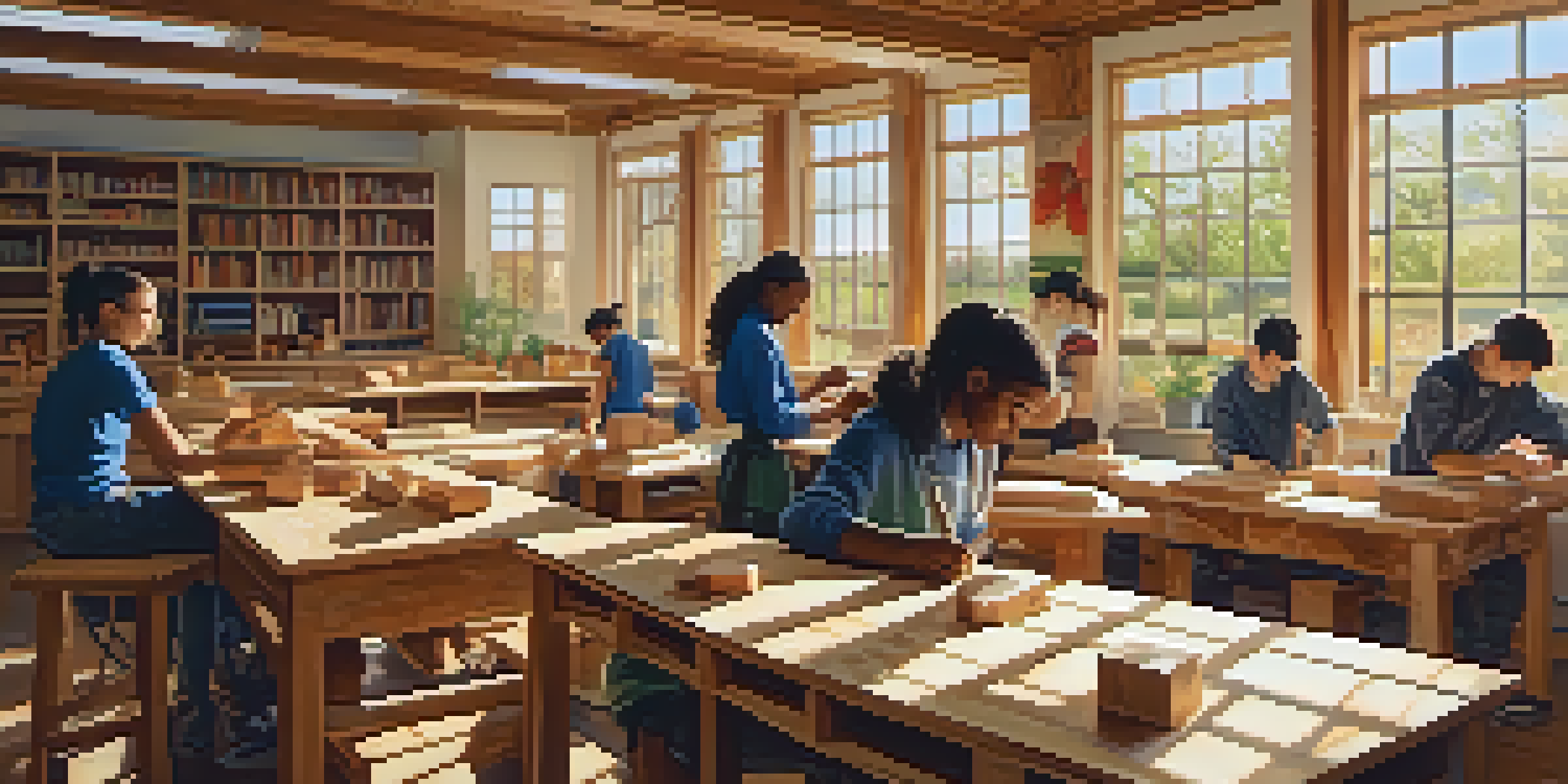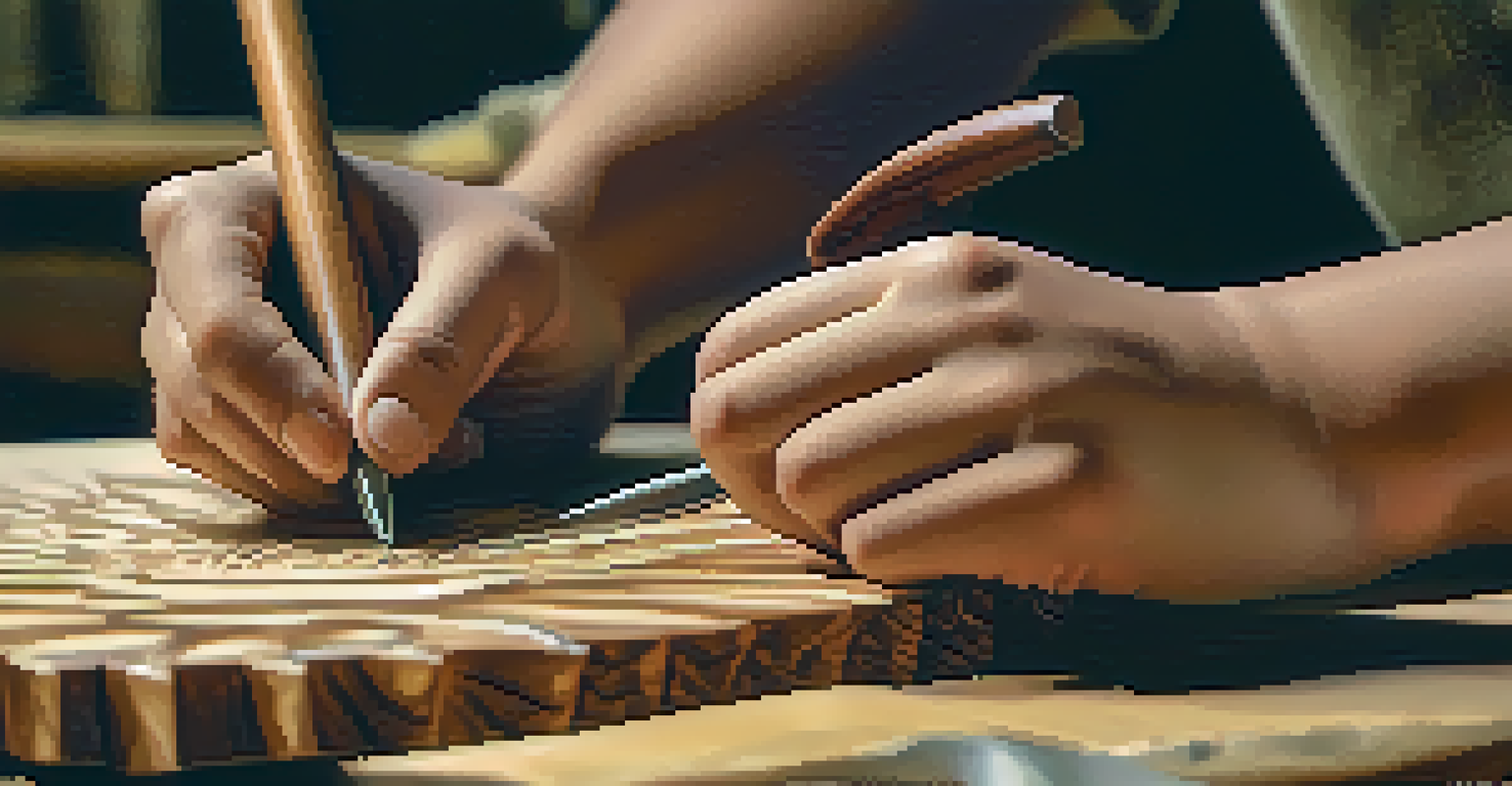Carving as a Therapeutic Tool in Special Education Programs

Understanding Carving as a Therapeutic Medium
Carving, often seen as an art form, can also serve as a powerful therapeutic tool. It allows individuals to express their emotions and creativity in a structured way. For students with special needs, this form of tactile engagement can lead to significant emotional and cognitive benefits. Just like molding clay, carving provides a tangible outlet that can help in processing complex feelings.
Art is not what you see, but what you make others see.
In special education programs, carving can be particularly beneficial for those who may struggle with traditional communication methods. The act of shaping wood or other materials can serve as a non-verbal form of expression. This is akin to painting or drawing but adds the dimension of physicality that can be deeply satisfying and grounding. It’s a way for students to communicate their inner world without the constraints of verbal language.
Moreover, carving can be an inclusive activity that promotes social interaction. When students work together on a project, they build camaraderie and develop teamwork skills. This shared experience can enhance their sense of belonging, which is crucial for emotional well-being, ultimately fostering a supportive classroom environment.
Benefits of Carving for Emotional Regulation
One of the most profound benefits of carving in special education is its ability to aid in emotional regulation. Carving requires focus and patience, which can help students learn to manage their impulses and emotions. As they concentrate on shaping their material, they can experience a calming effect, similar to meditation. This mindful engagement can be a valuable tool for those who often feel overwhelmed.

Additionally, the process of creating something tangible can boost self-esteem. Each completed piece of art serves as a visible achievement that students can take pride in. This sense of accomplishment can be particularly impactful for students who may struggle in other areas of their education. When they see their progress in carving, it instills a sense of capability and confidence.
Carving Enhances Emotional Regulation
Carving helps students manage their emotions and impulses through focused, mindful engagement, similar to meditation.
Furthermore, the physical act of carving can also serve as a form of stress relief. The repetitive motion and the satisfaction that comes from working with one’s hands can reduce anxiety levels significantly. It’s a constructive way to channel energy and emotions, making it easier for students to navigate their feelings.
Enhancing Fine Motor Skills Through Carving
Carving is not just an artistic endeavor; it also enhances fine motor skills, which are crucial for daily tasks. For students with special needs, developing these skills can lead to greater independence. The precision required in carving helps improve hand-eye coordination and dexterity, which are fundamental for activities like writing or buttoning a shirt.
Creativity takes courage.
As students carve, they practice grip strength and control, which are essential for manipulating tools safely. This hands-on experience translates into improved coordination in other aspects of their lives. Think of it as a workout for their hands, strengthening their abilities in a fun and engaging way.
Moreover, these improved motor skills can foster a greater sense of achievement. As students master carving techniques and create intricate designs, they gain a better understanding of their physical capabilities. This newfound confidence can motivate them to tackle other challenges, both in and out of the classroom.
Fostering Creativity and Imagination in Students
Carving allows students to tap into their creativity and imagination, which can be especially empowering. The freedom to create something unique encourages self-expression and exploration. Unlike structured assignments, carving projects can take on many forms, allowing each student to infuse their personality into their work. This creative outlet can be liberating, particularly for those who feel constrained in traditional educational settings.
In the process of designing their carvings, students often engage in problem-solving and critical thinking. They must plan their designs, consider the materials, and troubleshoot any issues that arise. This creative process not only stimulates their minds but also teaches them resilience, as they learn to adapt and revise their ideas.
Boosts Fine Motor Skills
The precision required in carving significantly improves hand-eye coordination and dexterity, fostering greater independence.
Additionally, celebrating creativity in the classroom helps to cultivate an appreciation for the arts. When students see their peers’ work, it can inspire collaboration and new ideas. This exchange of creativity fosters a vibrant classroom culture, where imagination thrives and everyone feels valued.
Building Social Skills Through Collaborative Projects
Collaboration is a key component of successful learning, and carving projects can create opportunities for students to work together. Group carving sessions encourage communication and cooperation, helping students to develop vital social skills. As they discuss their ideas and share tools, they learn the importance of teamwork and respecting each other’s contributions.
Working in pairs or small groups also allows students to practice empathy. They must listen to each other’s viewpoints and find common ground in their projects. This interaction can be particularly beneficial for students on the autism spectrum, who may find social cues challenging. Carving together provides a structured environment for practicing these skills in a supportive setting.
Furthermore, the shared experience of completing a project can create lasting friendships. As students bond over their carvings, they build relationships that extend beyond the classroom. These connections can be vital for their overall development, fostering a sense of community and belonging.
Integrating Carving into the Curriculum
Integrating carving into special education curricula can enhance traditional learning methods. By incorporating hands-on activities, educators can engage students on multiple levels, appealing to different learning styles. For visual and kinesthetic learners, carving can make abstract concepts more tangible and relatable. It’s a way to bridge the gap between theory and practice, making learning more meaningful.
Teachers can align carving projects with various subjects, such as history or science, enriching the educational experience. For instance, students can carve historical figures or scientific models, blending creativity with academic content. This interdisciplinary approach not only makes lessons more exciting but also helps students see the relevance of their studies in real life.
Fosters Collaboration and Social Skills
Group carving projects encourage communication and teamwork, helping students develop vital social skills in a supportive environment.
Moreover, carving can serve as a tool for assessing student progress. Teachers can evaluate not only the final product but also the process, observing students' growth in various areas. This holistic approach to assessment provides a more comprehensive view of a student’s abilities and achievements.
Conclusion: The Power of Carving in Special Education
In conclusion, carving emerges as a multifaceted therapeutic tool in special education programs. It supports emotional regulation, enhances fine motor skills, and fosters creativity while encouraging social interaction. By providing students with a unique outlet for expression, carving helps them build confidence and independence.
The benefits of this art form extend beyond the classroom, equipping students with skills they can carry into their everyday lives. As they carve, they learn about themselves, their abilities, and the importance of collaboration. It’s a journey of personal growth that can leave a lasting impact on their educational experience.

Ultimately, integrating carving into special education is not just about creating art; it’s about nurturing well-rounded individuals. By embracing this therapeutic tool, educators can open doors to new possibilities, empowering students to thrive both academically and emotionally.